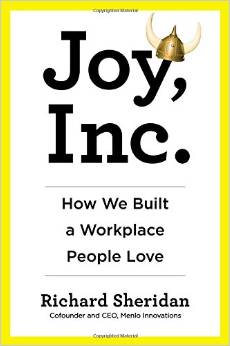Corporate joy? Is that an oxymoron?
It doesn’t have to be, according to Richard Sheridan. His company, Menlo Innovations, is devoted to “ending human suffering in the world as it relates to technologyÂ.”
Sheridan’s book, Joy, Inc., (which was originally released in 2013), is a fascinating look inside his team’s “joy factory.”
The casual reader might be tempted to approach this book with some healthy skepticism. The title conjures up a mental image conjured of a bunch of forced-wacky Kool-Aid drinkers.
In reality, the book provides a detailed explanation of systems, methods, and daily processes that are intended to result in joy. Joy for the employees, for the clients, and for the lucky end-users of the software being created.
Learning and teaching are at the core of the Menlo system, where colleagues work in pairs and progress is quite visibly measured on the walls. Humans need to feel that they are making progress in order to be happy, and that need is systematized at Menlo.
Here are just some of the ways Sheridan and his crew build joy:
- Avoid having “knowledge towers,” employees who are the sole repositories of certain information.
- Eliminate bureaucracy, and unnecessary meetings wherever possible. Consider having a daily standup where only those with useful information to share speak.
- Use what Sheridan calls “High-Speed Voice Technology.” Talk to each other, openly and frequently. Stop texting and emailing people who are in the same building. Build relationships, which build value.
- One of the key elements of a joyful culture is having team members who trust one another enough to argue. Stop hiring people who all agree with each other.
- Consider reverse show and tell. Rather than presenting your client with a progress report, ask the client to tell the team what is going on with the project.
- Use physical artifacts for planning and task execution, so that everyone can immediately see progress and status.
- Hire for joy and build that into the entire process. Look at the human, not the resume.
- Whatever you’re making, build in the delight/joy for the end-user as well. Find a way to build links between your staff and whomever will be using the work product. Menlo has a special position called “high tech anthropologist,” which is the link between programmers and end-users.
- Create an atmosphere free of fear. You can fail, you can experiment. Don’t get stuck on something just because you’ve already invested a lot of time in it.
- Break important HR rules, etc., like having babies or dogs in the office, as long as it’s part of your authentic culture.
- Share leadership, and be vulnerable. Share your vision and encourage new leaders.
- Strive for clarity and discipline.
- Incorporate flexibility as part of the culture, as much as possible. This makes it easier to start new initiatives.
- Accountability is important, but only when everyone is accountable, top to bottom.
- Employees need the “ability to go to work and get meaningful things done.” Values must be pervasive and visible in every aspect of the business, from the work space to contracts, to partner agreements.
Menlo is serious about transparency. The conclusion of the book punctures the idea that it is utopia. There are problems, as there always will be when humans are involved. The key difference is that here, problems are openly acknowledged and tackled as a team, not behind closed doors.
I’d strongly recommend this book to anyone who is considering building a business, and especially those who are already running a business. There are ideas galore, and even if you aren’t producing software, Sheridan challenges you to find the joy in your daily business.
Do you look at joy as a business value?
Disclosure: I was provided a digital review copy of this book. My opinion is from the heart.
